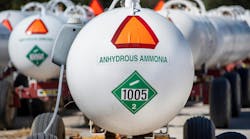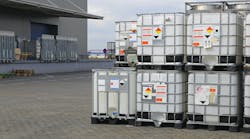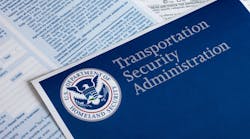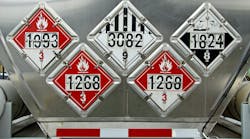CANADIAN regulations are very similar to US DOT regulations when it comes to loading and unloading cargo tanks, but there are some unique differences.
In his presentation, “Oh, Canada: What You Need to Know Before Crossing the 49th Parallel,” Rattan Bahia, regulatory specialist for Trimac Transportation Inc, discussed important changes that have taken place in Canadian regulations for companies that do business in Canada. Bahia delivered his presentation during National Tank Truck Carriers’ 2017 Tank Truck Week in New Orleans, Louisiana.
One major difference concerns emergency discharge control. The Canadian standard previously required a passive system shutdown, which could be on a trailer system or a hose. But after a serious incident in a truck-to-truck transfer, Transport Canada’s investigation zeroed in on one question: If an off-truck system shutdown is being use by smaller tanks such as bobtail tanks, why isn’t it used on large tank transports?
“Transport Canada said the system exists,” Bahia said. “Off-truck systems can shut down product discharge. So what we have now is a requirement for an off-truck shutdown on all cargo tanks, or highway tanks as they’re called in Canada. After that, you have a choice: You can have a passive system whereby it’s a hose or on-trailer sensing device that’s connected to the liquid discharge valves, or you can have a query monitoring system that kicks in every four minutes and 30 seconds. But the primary requirement, of course, is the off-truck system shutdown. And that system must be installed on cargo tanks manufactured after January 1, 2016.”
No person shall load in Canada a TC331 manufactured after January 1, 2016, unless it’s equipped with an appropriate emergency discharge control as specified in CSA B620-2014.
An MC330 or MC331 cargo tank shall comply with the emergency discharge control requirements in this clause as though it were a TC331 tank.
“This is not a retrofit rule,” he said. “That means it doesn’t apply to all cargo tanks—only those manufactured effective January 1, 2016. It’s not a retrofit yet. When the next standard comes into force, which could be around 2019 or 2020, then it will become a retrofit rule and it’ll apply to loading and unloading. So it’s a very critical and important change that will affect your business if you’re loading or unloading in Canada. At this point, it is only a loading requirement.”
Other regulations:
• If you’re parked for loading or unloading a Class 2.1 or Class 3 tank, you must have a fail-safe brake interlock system or chock blocks.
“I know most tank manufacturers will incorporate brake interlock systems into their loading and unloading devices, but the option is you can have wheel chocks as well,” he said. “But the wheel chocks pose another problem. You need to then worry about load securement.
• For diesel engine trucks, if you are loading or unloading in Canada, the truck must have an automatic engine air intake shutoff device to prevent engine runaway. The rules are applicable irrespective of dates of manufacture.
• Non-spec cryogenic cargo tanks are acceptable for use in Canada as long as they are: constructed and certified in accordance with (iaw) 49CFR; constructed to the terms of the standard CGA 341 and referenced ASME Code; and are manufactured prior to January 1, 2003.
“Inspections are required the same as with a spec tank,” he said. “So if you’re coming into Canada, it’s a CGA 341. It needs to be manufactured before January 1, 2003. And you’d have to do all the Part 180 equivalent tests, which are found in Clause 7 of the B620 standard.”
• In the United States, hose assemblies have requirements to be tested and inspected (US DOT Ref: 49 CFR Part 180.416), and that’s applicable to compressed gases only. In Canada, it’s applicable to all hazmat hose assemblies.
“For product delivery and vapor return hoses temporarily connected and used for loading and unloading of all regulated hazmat products, there’s an annual visual inspection and pressure test,” he said. “Markings have to be legible—tagged on the end of the hose on a coupling. It’s no different than what you do for compressed gas. Clause 7 tells you what the different hose test pressures are for the different types of commodities being in loading or unloading activities.”
• Compressed gas must be handles with CSA certified hoses with a minimum pressure of 350 psi, which is same in US DOT regulations. Gravity hoses are 10 psi. Vapor return hoses in 306/406 use are tested at 10 psi.
“Here’s the difference, though: We have a different term. It’s not MAWP (Maximum Allowable Working Pressure), it’s HAWP—Hose Assembly Working Pressure. HAWP is the anticipated working pressure of the hose assembly, which doesn’t exceed the maximum working pressure of the lowest-rated component. The lowest-rated component could be the fitting at the end of the hose, the hose assembly, or a pressure bypass valve on your tank truck. Vapor return hoses are 306/406, 10 psi. For all other hose assemblies, it’s the greater of 120% of the marked HAWP of the hose assembly and 75 psi.
“In terms of cargo tank inspection and test facility requirements, Canada’s regulations don’t require those facilities be registered with Transport Canada. You can be a non-registered entity. You would still need documentation control, training, and so forth. All training must be documented to make sure workers understand safety protocols, the regulation, and past failures.”
Bahia said Canada has tightened up procedures to deal with the problem of missing, lost, or illegible spec data plates, which are also called metal identification plates.
“Cargo tank owners and operators getting anyone to fabricate a plate stamp it, mark it, and slap it in a tank,” he said. “Now we have an in-depth process whereby if your plate is missing and you have to replace a plate, then there’s a process you must follow. A key requirement is you must have the original certificate of compliance for that tank trailer. You must have both spec plates visible and the two must correlate. Then there is a form that’s signed by the tank owner and the facility that’s going to attach the replacement plates. We recognized some loopholes and some gaps in the previous rule and just closed them up.”
Canada also now has a stricter procedure to go through when filling out the form following repairs of cargo tanks.
“If you have done a repair by welding, then you must have a repair report, and there’s a list of attributes that must be included on the repair report,” he said. “The main one is, if you have a welder that’s welding on that tank, the welder must be qualified. On the end of that form, you must have the welder’s name and signature.
“On top of that, you must show what weld procedure you used to repair that tank. The weld procedure number must be documented. It’s actually a good process where if auditors and regulators want to come in and there’s an incident and they want to find out why this tank ruptured or leaked, you can track it back. Did the facility have a qualified welder? Who’s the welder? Did he have a qualified weld procedure? This is only for tanks that are repaired in Canada.”
Bahia also clarified the “R” stamp issue.
“In the United States, if you’re repairing a tank by welding, then you’re required to have an ‘R’ stamp,” he said. “That’s not the case in Canada. In Canada, if it’s a non-pressure tank—let’s say a gasoline trailer, 406, 306—you don’t need the ‘R’ stamp, but you still must have certain quality control requirements. You don’t have to have the third party audit process by the National Board. You only have to have internal quality control processes.
“But for pressure tanks—let’s say, 331—if they’re repaired by welding, you have a choice in Canada. You can obtain an ‘R’ stamp or what we call the Provincial Pressure Vessel Certificate of Authorization that’s issued by a province. Each province has a pressure vessel jurisdiction. That authority must issue you a certificate. It’s almost the same as the National Board ‘R’ stamp review. But what the US DOT regulators and Canadian regulators have come up with is, if you have a domicile tank in the United States and it needs to be repaired in Canada, the repair facility doesn’t have to have the ‘R’ stamp. It probably does already, but the repairs meet code as long as that facility has a Provincial Pressure Vessel Certificate of Authorization from the province.”








